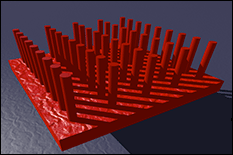New nanoscale solar cells could revolutionize solar industry

University of Maryland Department of Electrical and Computer Engineering Assistant Professor Jeremy Munday and graduate students Yunlu Xu and Tao Gong have designed a new type of nanoscale solar cell that they predict could outperform traditional devices by as much as 40 percent. This new technology could revolutionize the solar industry by allowing for significantly more power generation from a single device by simply making it much smaller.
Xu, Gong, and Munday had their research on the Shockley-Queisser limit for nanostructured solar cells published in Scientific Reports, an online, open access journal from the publishers of Nature. The journal publishes scientifically valid primary research from all areas of the natural and clinical sciences.
The Shockley-Queisser limit describes the maximum solar energy conversion efficiency achievable for a particular material and is the standard of comparison for new photovoltaic technologies. For a standard solar cell, this efficiency limit is ~33 percent. However, recently people have wondered if nanoscale solar cells are also bounded by this limit.
Now Xu, Gong, and Munday have shown that a single-junction nanostructured solar cell has a theoretical maximum efficiency of ~42 percent under typical solar illumination. This exceeds the efficiency of a traditional planar device but does not exceed the Shockley-Queisser limit for a planar device with optical concentration, e.g. a solar cell using a lens to concentrate the light. The researchers found that nanostructured solar cells offer an important avenue to achieving high efficiency photovoltaic devices through a "built-in optical concentration." Even when they consider the effects of light scattering in the atmosphere, nanostructured solar cells can achieve 35.5 percent efficiency with a modest built-in optical concentration of only ~1,000.
As Munday and his team continue to design and fabricate nanoscale solar cells they find the biggest challenge is nano-fabrication. "You start with a solar cell that works well, and then you perform some extreme treatments to structure it on the nanoscale, all without causing any harming," said Munday. "Luckily, we've found a few materials and processes that look promising and have a team of dedicated students determined to make a big impact in solar energy."
More information: "The generalized Shockley-Queisser limit for nanostructured solar cells." Scientific Reports 5, DOI: 10.1038/srep13536
Journal information: Scientific Reports , Nature
Provided by University of Maryland




















